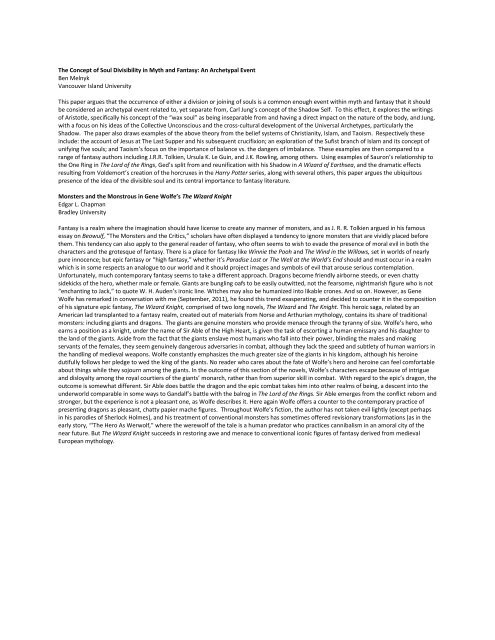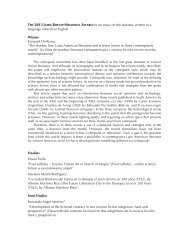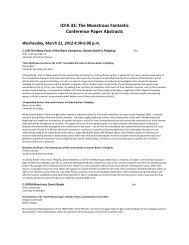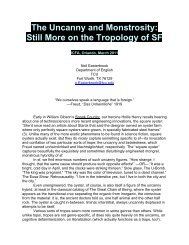14. (SF) Nature, Humanity, and Alterity in the Fiction of Philip K. Dick Captiva AChair: Douglas R. FisherAuburn UniversityElectric Nature: Constructing Wilderness in Do Androids Dream of Electric Sheep?Aaron CloydUniversity of KentuckyThis paper seeks to approach Philip K. Dick’s Do Androids Dream of Electric Sheep? as a work contextualized by the wilderness movement in thelate 1960s. Published in 1968, against a background of the burgeoning counter-cultural movement, Dick’s novel reflects multiple expressions ofthe anti-bureaucratic, anti-establishment milieu of its time. One such movement was the emerging environmental movement, specifically theshifting perspective on wilderness areas. As Roderick Nash observes in Wilderness and the American Mind, throughout the 1960s wildernesscame to represent the antithesis to the controlled and created structures of corporate America. As opposed to sites of the establishment,wilderness was interpreted as a natural locale, as a place purified from the trappings of civilization, as a way to redeem society and locate afresh re-beginning to the world. By attending to Dick’s complex portrayal of wilderness, this essay aims to posit Do Androids Dream of ElectricSheep? as a critical text in the wilderness debate, one that reveals the often unexamined assumptions of nature and the constructed.“And are we not men?” – <strong>The</strong> <strong>Monstrous</strong> Symmetries of Do Android’s Dream of Electric Sheep and ThirteenMaura Heaphy<strong>The</strong> Ohio State University<strong>The</strong>re are so many points of contact between Richard K. Morgan’s 2007 novel Thirteen (UK: Black Man) and Philip K. Dick’s Do Android’s Dreamof Electric Sheep, that it is possible to read it as a variation on the themes raised in Dick’s classic work. In Thirteen, a morally-conflicted bountyhunteris forced to track down enhanced humanoids – Type Thirteens (or “twists”) – who have escaped to Earth from enforced exile on Mars,leaving a trail of death and mayhem in their wake. In the course of his investigation, bounty-hunter Carl Marsalis (just like Rick Deckard, beforehim) encounters “regular” humans who fear and loathe Thirteens, who are sexually attracted to them, who exploit them and kill them withouta second thought, because they are not “really human.” Like Dick before him (and like H.G. Wells before that), in Thirteen Richard K. Morganaddresses important issues about what it means to be human. Investigating the echoes of Do Androids Dream …. and Blade Runner in his novelwill provide interesting new insights into Dick’s classic, and fresh evidence of Morgan’s importance as a new voice in SF.<strong>The</strong> Three Alterities of Palmer EldritchRichard Viskovic<strong>The</strong> University of AucklandWhen Philip K. Dick wrote <strong>The</strong> Three Stigmata of Palmer Eldritch, he was inspired by the waking nightmare. A vision of a “vast visage of perfectevil” watched him from the sky when he walked to and from his secluded study; “it had empty slots for eyes -- it was metal and cruel and, worstof all, it was God” (Sutin 127). <strong>The</strong> fantastic vision was clearly the stimulus for the monstrous character Palmer Eldritch, about whom the novelrevolves. <strong>The</strong> novel, in one account, can be viewed as an attempt to exorcise this vision that had such terrible fascination and power over theauthor. N. Katherine Hayles describes the entire narrative as a series of strategies designed to mitigate the horror of the vision, whichultimately fail because they must do justice to the vision’s power (Hayles 74). This paper unpacks the fears Eldritch represents. Beginning withthe idea that Eldritch embodies a radical form of alterity caused by a triple taint of alien, machine and God, and exploring the fear such alteritycan inspire, the paper moves on to identify the real locus of dread, not in the alterity itself, but in Eldritch’s seemingly contradictory power toenter an individual’s idios kosmos and become as familiar as one’s own thoughts.15. (F) Influences, Divided Souls, and Truly Scary Monsters Captiva BChair: Stefan EkmanLund University<strong>The</strong> Magician’s Nephews: Grossman, Pullman, and the Anxiety of InfluenceLeah ZanderBennington CollegeIn <strong>The</strong> Anxiety of Influence: A <strong>The</strong>ory of Poetry, Harold Bloom declares, “Influence is…a disease of self-consciousness”. While Bloom wasspeaking specifically of poetry, his theory of the anxiety of influence has implications for the study of novels of the fantastic as well. Modernfantasists seem to be acute sufferers of the “disease of self-consciousness”. Lev Grossman’s <strong>The</strong> Magicians name-checks Harry Potter and <strong>The</strong>Chronicles of Narnia in-text. Philip Pullman’s His Dark Materials series has been acknowledged by the author to be a critical response to theworks of C.S. Lewis, whom Pullman has been quite open about disliking. Indeed, it seems that both <strong>The</strong> Magicians and His Dark Materials canbe most completely understood only within the context of their relationship to their shared antecedent—and it is a highly antagonisticrelationship at that. Grossman dismantles Lewis’s notion of the fantasy world as escape, while Pullman’s trilogy aggressively rejects Lewis’sChristian theology, even going so far as to have his pubescent protagonists kill God. Here we see a clear connection to Bloom’s theory: bothPullman and Grossman must, like Oedipus, kill their literary forbearer in order to assuage their anxiety of influence and create an original work.However, this theory, while useful, has limited application within the context of Pullman and Grossman. After all, by so explicitly acknowledgingtheir influence and dealing so directly with its conventions, they have tied themselves inextricably to the legacy of Lewis. If Lewis does ‘die’ inthis process it is only to haunt these works like a Shakespearean ghost, becoming an even more potent force than he was in ‘life’. After all, canwe really consider a work original if it depends upon such a complex web of intertextual associations in order to be successful?
<strong>The</strong> Concept of Soul Divisibility in Myth and Fantasy: An Archetypal EventBen MelnykVancouver Island UniversityThis paper argues that the occurrence of either a division or joining of souls is a common enough event within myth and fantasy that it shouldbe considered an archetypal event related to, yet separate from, Carl Jung’s concept of the Shadow Self. To this effect, it explores the writingsof Aristotle, specifically his concept of the “wax soul” as being inseparable from and having a direct impact on the nature of the body, and Jung,with a focus on his ideas of the Collective Unconscious and the cross-cultural development of the Universal Archetypes, particularly theShadow. <strong>The</strong> paper also draws examples of the above theory from the belief systems of Christianity, Islam, and Taoism. Respectively theseinclude: the account of Jesus at <strong>The</strong> Last Supper and his subsequent crucifixion; an exploration of the Sufist branch of Islam and its concept ofunifying five souls; and Taoism’s focus on the importance of balance vs. the dangers of imbalance. <strong>The</strong>se examples are then compared to arange of fantasy authors including J.R.R. Tolkien, Ursula K. Le Guin, and J.K. Rowling, among others. Using examples of Sauron’s relationship tothe One Ring in <strong>The</strong> Lord of the Rings, Ged’s split from and reunification with his Shadow in A Wizard of Earthsea, and the dramatic effectsresulting from Voldemort’s creation of the horcruxes in the Harry Potter series, along with several others, this paper argues the ubiquitouspresence of the idea of the divisible soul and its central importance to fantasy literature.Monsters and the <strong>Monstrous</strong> in Gene Wolfe’s <strong>The</strong> Wizard KnightEdgar L. ChapmanBradley UniversityFantasy is a realm where the imagination should have license to create any manner of monsters, and as J. R. R. Tolkien argued in his famousessay on Beowulf, “<strong>The</strong> Monsters and the Critics,” scholars have often displayed a tendency to ignore monsters that are vividly placed beforethem. This tendency can also apply to the general reader of fantasy, who often seems to wish to evade the presence of moral evil in both thecharacters and the grotesque of fantasy. <strong>The</strong>re is a place for fantasy like Winnie the Pooh and <strong>The</strong> Wind in the Willows, set in worlds of nearlypure innocence; but epic fantasy or “high fantasy,” whether it’s Paradise Lost or <strong>The</strong> Well at the World’s End should and must occur in a realmwhich is in some respects an analogue to our world and it should project images and symbols of evil that arouse serious contemplation.Unfortunately, much contemporary fantasy seems to take a different approach. Dragons become friendly airborne steeds, or even chattysidekicks of the hero, whether male or female. Giants are bungling oafs to be easily outwitted, not the fearsome, nightmarish figure who is not“enchanting to Jack,” to quote W. H. Auden’s ironic line. Witches may also be humanized into likable crones. And so on. However, as GeneWolfe has remarked in conversation with me (September, 2011), he found this trend exasperating, and decided to counter it in the compositionof his signature epic fantasy, <strong>The</strong> Wizard Knight, comprised of two long novels, <strong>The</strong> Wizard and <strong>The</strong> Knight. This heroic saga, related by anAmerican lad transplanted to a fantasy realm, created out of materials from Norse and Arthurian mythology, contains its share of traditionalmonsters: including giants and dragons. <strong>The</strong> giants are genuine monsters who provide menace through the tyranny of size. Wolfe’s hero, whoearns a position as a knight, under the name of Sir Able of the High Heart, is given the task of escorting a human emissary and his daughter tothe land of the giants. Aside from the fact that the giants enslave most humans who fall into their power, blinding the males and makingservants of the females, they seem genuinely dangerous adversaries in combat, although they lack the speed and subtlety of human warriors inthe handling of medieval weapons. Wolfe constantly emphasizes the much greater size of the giants in his kingdom, although his heroinedutifully follows her pledge to wed the king of the giants. No reader who cares about the fate of Wolfe’s hero and heroine can feel comfortableabout things while they sojourn among the giants. In the outcome of this section of the novels, Wolfe’s characters escape because of intrigueand disloyalty among the royal courtiers of the giants’ monarch, rather than from superior skill in combat. With regard to the epic’s dragon, theoutcome is somewhat different. Sir Able does battle the dragon and the epic combat takes him into other realms of being, a descent into theunderworld comparable in some ways to Gandalf’s battle with the balrog in <strong>The</strong> Lord of the Rings. Sir Able emerges from the conflict reborn andstronger, but the experience is not a pleasant one, as Wolfe describes it. Here again Wolfe offers a counter to the contemporary practice ofpresenting dragons as pleasant, chatty papier mache figures. Throughout Wolfe’s fiction, the author has not taken evil lightly (except perhapsin his parodies of Sherlock Holmes), and his treatment of conventional monsters has sometimes offered revisionary transformations (as in theearly story, “'<strong>The</strong> Hero As Werwolf,” where the werewolf of the tale is a human predator who practices cannibalism in an amoral city of thenear future. But <strong>The</strong> Wizard Knight succeeds in restoring awe and menace to conventional iconic figures of fantasy derived from medievalEuropean mythology.
- Page 4 and 5: 5. (F) Wondrous Bodies of the Gende
- Page 6 and 7: Fantastic Suicide: Reading the Unca
- Page 8: Viral Posthumanism: Boundaries and
- Page 13 and 14: Thursday, March 22, 2012 10:30 a.m.
- Page 15 and 16: 21. (CYA) Terrifying Futures: Post-
- Page 17 and 18: 23. (FTV/H) Now I’m Feelin’ Zom
- Page 19 and 20: Fight Club: Amalgam of the Horrific
- Page 21 and 22: Taking the Monsters out of the Clos
- Page 23 and 24: Kaspar J. SaxenaIndependent Scholar
- Page 25 and 26: 44. (CYA) The Monstrosity of Teenag
- Page 27 and 28: 46. (FTV/SF) Monstrous Spin-offs: T
- Page 29 and 30: 49. (F) Aspects of Miéville Captiv
- Page 31 and 32: 53. (SF) War and Crisis in 1940s an
- Page 33 and 34: Abuse of Power: An Evolutionary Res
- Page 35 and 36: Disappearing Natives: The Colonized
- Page 37 and 38: 60. (H/IF) Ancient and Medieval Mon
- Page 39 and 40: 62. (F) The Works of Tolkien Captiv
- Page 41 and 42: 67. (SF) Imperial and Postcolonial
- Page 43 and 44: Beheading the Gorgon: Beautifying C
- Page 45 and 46: 71. (VPA) Monstrous Music MagnoliaC
- Page 47 and 48: 73. (F/IF) Portraying New Worlds Ca
- Page 49 and 50: Friday, March 23, 2012 2:45-3:45 pm
- Page 51 and 52: 81. (FTV) Those Damn Dirty Apes! Cy
- Page 53 and 54: Friday, March 23, 2012 4:00-5:30 pm
- Page 55 and 56: 92. (F) Leaving the Demonized Other
- Page 57 and 58: 94. (FTV/CYA) Monstrosity and Devia
- Page 59 and 60:
of cannibalism, ghostly seduction i
- Page 61 and 62:
Saturday March 24, 2012 8:30-10:00
- Page 63 and 64:
104. (CYA) Classic Monsters, Reinte
- Page 65 and 66:
107. (VPA) Monstrous Gaming Bodies
- Page 67 and 68:
who challenge the order that the Br
- Page 69 and 70:
Reading Between the Times: A Critic
- Page 71 and 72:
117. (FTV) Monsters and Superheroes
- Page 73 and 74:
119. (IF/H/PCS) International Mash-
- Page 75 and 76:
Focusing on Stoker's Dracula as one
- Page 77 and 78:
Florida Atlantic UniversitySheri S.
- Page 79 and 80:
Simmons CollegeIn the spate of rece
- Page 81 and 82:
Independent ScholarKing’s story
- Page 83 and 84:
modernity opens up for every indivi
- Page 85 and 86:
Saturday March 24, 2012 4:00-5:30 p
- Page 87 and 88:
141. (FTV) Monstrous Masculinity Cy
- Page 89 and 90:
ultimately make peace with her mons
- Page 91 and 92:
where the almost-human sentient zom





